6. Agriculture
| indicator |
policy issue |
DPSIR |
assessment |
| eco-efficiency in agriculture |
has the sector made progress? |
pressure |
 |
| livestock numbers |
what have been the developments in
environmental aspects of agriculture: ... with regard to
eutrophication? |
driving force |
 |
| fertiliser consumption per
hectare |
- " - |
driving force |
 |
| irrigated land |
... with regard to water
stress? |
driving force |
 |
| pesticide consumption per
hectare |
... with regard to water
quality? |
driving force |
 |
| area with organic farming |
... with regard to less
environment-burdening farming systems? |
response |
 |
Agriculture has become more environmentally
efficient overall, but pressures seem to remain at the same level,
notwithstanding wide regional disparities. This is mainly due to
continuing intensification — and the resultant use of large and
environmentally-critical amounts of pesticide and fertiliser. On
the other hand, the area of agricultural land under management
contracts or farmed organically has increased.
The agriculture sector, which represents 2.3 %
of EU gross domestic product and 5.3 % of employment, is clearly
subject to structural changes under the Common Agricultural Policy
(CAP) and its subsequent reforms. The size and diversity of
agriculture have also been substantially influenced, and will
remain so, by changing consumer demands, changing rural patterns,
technological advances and globalisation of the economy. These
trends are seen as having positive as well as negative effects on
the sector's performance with regard to environmental quality and
nature conservation.
The concept of the `multifunctionality' of
agriculture, as underlined by Agenda 2000, tries to capture the
various challenges for the sector: to produce food, fibres and
energy sources; to preserve the rural environment and landscape;
and to contribute to the viability of rural areas and a balanced
regional development. From an environmental point of view,
balancing these various aims is equal to improving eco-efficiency,
i.e. reducing the burden on the environment while maintaining a
certain level of output. Eco-efficiency in agriculture is
tentatively expressed in this report by comparing methane emissions
and selected inputs with developments in the gross value added
(which is approximately total income) of agriculture (Figure
6.1).
6.1. Some eco-efficiency aspects in
agriculture
Figure 6.1. Eco-efficiency in agriculture in
EU Member States
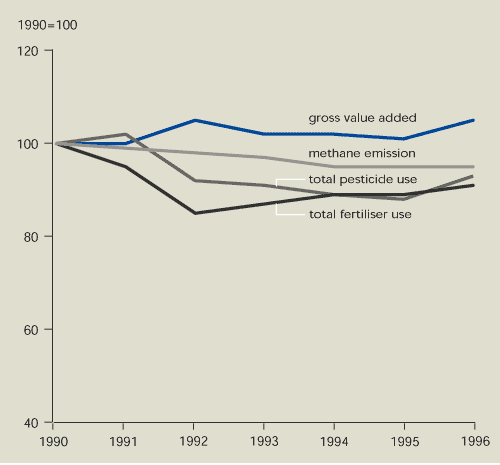
Source: EMEP, IPCC, ECPA, OECD, FAO and Eurostat
 Overall, eco-efficiency in agriculture has improved only
slightly since 1990.
Overall, eco-efficiency in agriculture has improved only
slightly since 1990.
Since 1980, gross value added in agriculture
has increased by about 25 % — a slower rate of growth than in other
sectors. Part of the increase is due to productivity gains and part
due to increasing consumer demand for luxury products with a high
added value. At the same time, fertiliser use has fallen and
stabilised (Figure 6.3) without affecting yield. Yields have been
boosted by plant technologies that increase the weight of the
edible part of the crop compared with the non-edible part. In
addition, more use has been made of organic manure. The fall in
methane emissions is associated with improved utilisation of animal
feeds in intensive livestock production and with the decline in
cattle (Figure 6.2).
These changes suggest that improvements in the
eco-efficiency of the agricultural sector are largely due to
independent developments in production efficiency as a result of
agricultural research and farmers' behaviour.
However, while efficiency has improved in
economic terms, the quantity of inputs per hectare has either
stayed constant or increased in recent years (Figure 6.3 and Figure
6.5). This is due to two trends: a steady decrease in the area of
agricultural land and more intensive production (with more value
added per hectare). Such a development is fully in line with the
CAP. At the start of the CAP, the major issue was product price
support; since the 1992 and 1999 revisions, most CAP funds have
been allocated to support farm incomes and provide compensatory
payments, with agri-environmental programmes receiving only a
relatively small share of the budget. The protected production
regime — with a possibly higher use of non-farm resources than
otherwise would be the case — stimulated intensification. In these
circumstances, integrating and implementing environmental policies
to reduce nitrogen surpluses, pesticide residues and/or water use
is a challenge. This may partly explain the slow progress made in
integrating environment in the agricultural sector.
The scale on which these developments have
occurred and are managed differs significantly within Europe. The
pattern and diversity of agriculture reflects Europe's geography
and political history. North-west Europe is generally associated
with large-scale, highly productive arable or livestock production,
while mixed and fragmented patterns of production are typical of
southern Germany, France and northern-central Italy (Potter, 1997).
Agriculture in southern Europe tends to be less intensive.
Nonetheless, parts of northern Europe also have important extensive
farming systems, such as upland areas and mountain regions, while
southern Europe has some intensive agriculture, such as intensive
horticultural crop production.
The net balance between the positive aspects of
farming (e.g. maintenance of cultivated landscapes and rural areas,
carbon sequestration, water management) and the negative aspects
(e.g. poor water quality, overuse of water, air pollution, loss of
biodiversity, soil degradation and waste) differs between regions.
It depends on a number of factors, ranging from natural ones (soil,
water availability, climate) to farm management practices
(intensification/extensification, agro-environment measures).
6.2. Trends in agriculture
Over past decades, EU agriculture has become
more specialised and concentrated in areas with the lowest
production costs. This process, driven largely by technological
change and cheaper and faster transport, has been accomplished by
increasing intensification on the best land and in key production
areas near important markets. For example, 80 % of the EU's
intensive production occurs in coastal areas of the North Sea and
the English Channel. Higher labour costs and declining prices have
also contributed to the reduced viability of farming in marginal
areas where afforestation, marginalisation or even complete
abandonment occur in some places.
Over the past 20 years, the area of land in
productive agriculture fell by 5 % and the amount of arable land
increased at the expense of permanent grassland. However, farmers
manage 44 % of Europe's land area, a fact that underlines
agriculture's key role in society.
Efforts to curb pressures on the environment
include the production of Codes of Good Agricultural Practice,
giving guidance to farmers and advisors on how to minimise
emissions to the environment (MAFF, 1988). Many Member States have
introduced measures in response to the Nitrates Directive, but have
generally not met its requirements. Some Member States have
introduced pesticide and fertiliser taxes, and agro-environment
measures following the 1992 CAP reform. Under Agenda 2000, Member
States are expected to develop Codes of Good Agricultural Practice
embracing the whole range of agriculture inputs of environmental
relevance.
6.2.1. Livestock numbers
Apart from cattle, overall numbers of pigs, poultry, sheep and goats have increased (Figure 6.2), but the total
agricultural area used by these types of farms has fallen. This
reflects the trend towards specialisation and intensification.
Recent food scares, concern about farm-animal welfare and the risks
associated with feedstuffs fed to farm animals have raised
questions about some modern farming systems.
Figure 6.2. Livestock numbers in EEA member
countries
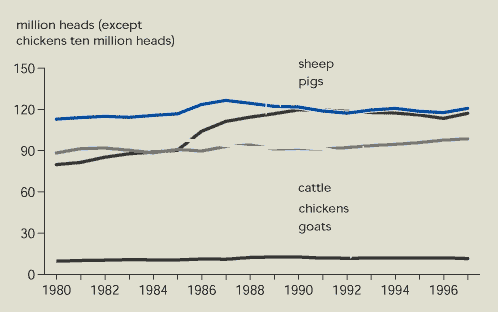
Source: FAO
Notes:
Chicken numbers are expressed as 10 million heads. Goat numbers not
included for Denmark, Ireland, Sweden and the UK. Chicken numbers
not included for Liechtenstein.
 Livestock numbers in EEA member countries have increased
overall. In certain regions, farms have become more concentrated
and the efficiency of livestock production has
increased.
Livestock numbers in EEA member countries have increased
overall. In certain regions, farms have become more concentrated
and the efficiency of livestock production has
increased.
Figure 6.3. Fertiliser consumption per
unit area of agricultural land in EEA member countries
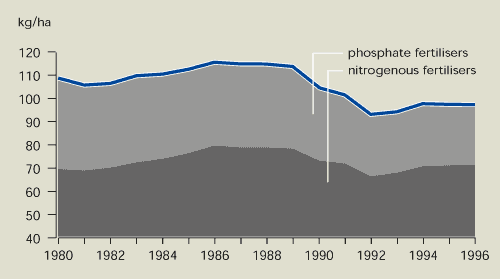
Source: FAO
Note: Liechtenstein not included.
 Use of nitrogen and phosphorus fertilisers has decreased
overall, but this trend has been reversed since 1992. Despite these
reductions, crop yields have continued to increase.
Use of nitrogen and phosphorus fertilisers has decreased
overall, but this trend has been reversed since 1992. Despite these
reductions, crop yields have continued to increase.
High densities of animal populations are
associated with excessive concentrations of manure — and an
increased risk of water pollution (see Chapter 13). The
contribution of livestock to gaseous emissions is also significant
— about 80-90 % of total EU ammonia emissions (from animal housing)
and 45 % of total methane emissions arise from animal husbandry
(see Figures 10.12 and 8.4).
6.2.2. Fertiliser use
The downward trend in the use of inorganic
fertiliser (nitrogen and phosphorus) has recently been reversed
(Figure 6.3 and Table 6.1). The use of manure to supplement or
replace inorganic fertilisers may explain some of the initial
decrease.
Legislation such as the Nitrates Directive and
Agri-environment Regulation EEC/2078/92 also seek to limit nutrient
losses to freshwater bodies. During the mid-1990s, Norway and
Sweden introduced fertiliser taxes — with Sweden aiming to reduce
nitrogen consumption by 20 % by 2000 (Pretty, 1998). Opinion is
divided as to whether these instruments have had an appreciable
effect on reducing fertiliser use.
Agriculture continues to be the main source of
nitrate pollution in Europe. The nitrogen surplus in the EU did not
fall between 1990 and 1995 (see Figure 13.3), affecting water
quality and potentially human health.
6.2.3. Irrigated land
Agriculture is a major consumer of water
(30 % of total water use in EEA member countries; see Figure 12.3)
compared with other sectors. Between 1980 and 1996, the area of
irrigated land expanded significantly (by about 15 %), particularly
in southern Europe (Figure 6.4). For example, the irrigated area in
France more than tripled from 870 000 hectares to 2.5 million
hectares between 1980 and 1995.
The main irrigated crop in terms of area is
maize. Irrigation is also used on other annual or permanent crops
to boost or stabilise yields as well as to ensure high-quality
produce. The expansion of irrigated area has increased the demand
and use of non-farm resources, thus exerting other burdens on the
environment besides water stress. More efficient ways of irrigating
land such as drip irrigation have reduced dosage rates, but this
improvement has often been offset by an increase in the irrigated
area.
The loss of agricultural habitats associated
with the drier, traditionally less intensive farming systems of
southern Europe is also of concern.
Figure 6.4. Irrigated land as a
percentage of total land area in southern and total EEA member
countries
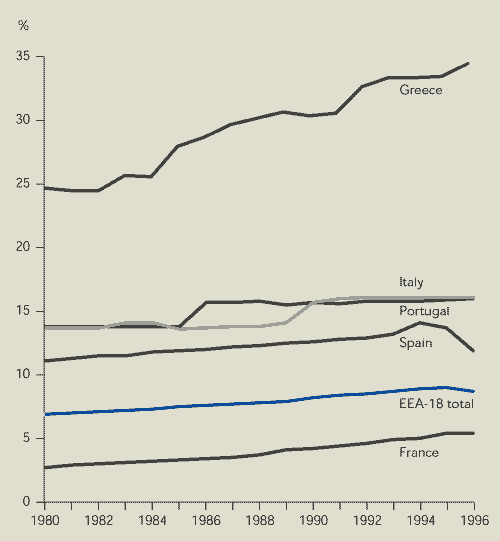
Source: FAO, Eurostat/NewCronos
Note: Data for Iceland, Ireland and Liechtenstein
not included in total.
For Denmark and the Netherlands, data shows all areas that can be
irrigated (i.e. farms have equipment for irrigation) and no
distinction is made between total irrigated areas and actual
irrigation.
 The area of irrigated land has increased slightly,
notably in southern European countries.
The area of irrigated land has increased slightly,
notably in southern European countries.
6.2.4. Pesticide use
The amount of pesticide (including
insecticide, fungicide, herbicide and other plant protection
products) used in terms of active ingredient has fallen since the
early 1990s, both in absolute amounts and in application rate
(Figure 6.5). The 1992 CAP reform may have contributed to a
decrease in the average use of pesticide per hectare. Another
factor is the simultaneous improvement in pesticides — making them
more effective and application-specific, but also more toxic.
However, a slight increase in use has occurred since 1995. Denmark,
Finland, France, Germany, the Netherlands and Sweden have set
targets to reduce pesticide use. Such an aim is also suggested by
the European Commission's fifth environmental action programme.
Nevertheless, modern agriculture continues to rely heavily on this
non-farm resource.
With a few exceptions such as atrazine, residue
concentrations do not appear to be falling despite EU legislation
relating to pesticide residues in treated crops, surface drinking
waters and groundwater (EEA, 1999).
Figure 6.5. Average pesticide
consumption per unit area of agricultural land in EEA member
countries
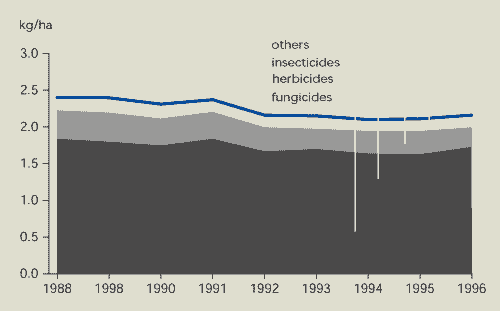
Source: Eurostat; FAO; ECPA; OECD
Note: Weight of active ingredients used.
 Despite greater awareness of the harm pesticides cause
to the environment and human health, dependence on pesticides has
not diminished.
Despite greater awareness of the harm pesticides cause
to the environment and human health, dependence on pesticides has
not diminished.
6.2.5. Environment-friendly farming
methods
While technical change has driven down costs for most agricultural
products, many consumers are now expressing a preference for food
produced using more traditional systems and giving priority to
farm-animals' welfare. At the same time, the 1992 CAP reform
introduced measures to reward farmers for public services such as
maintenance of landscapes and to induce farmers to reduce the
environmental impact of their activities through measures such as
favouring organic production.
The area under organic farming in EEA member
countries increased tenfold between 1985 and 1997 (Figure 6.6).
This rate of growth continues. However, the total area (2.9 million
hectare) remains small at just under 2 % of total agricultural
land. The increase in organic farming is unlikely to have had a
significant effect yet on the total environmental burden from
agriculture.
Organic farming should not be considered the
ultimate solution to agriculture’s envi-ronmental problems.
Individual organic farms often vary widely, and the environmen-tal
benefits of organic farming are dissimilar and diverse. Other forms
of farming systems such as Integrated Crop Management also
contribute to reducing the environmental burden from agriculture.
Nevertheless, the area under organic farming is a useful indicator
of progress towards more environment-friendly agriculture.
Figure 6.6: Area under organic farming
as a percentage of total agricultural area in EEA member
countries
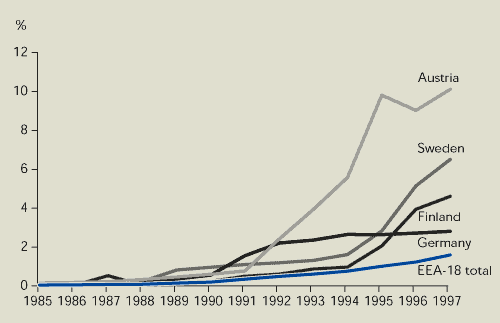
Source: FAO, Eurostat; Lampkin
Note: Accuracy of data varies between
countries.
 The rate of uptake of organic farming has increased
significantly. However, only a small number of Member States have
set targets to expand the area under organic farming, and the area
of EEA member countries under organic farming remains low at less
than 2 %.
The rate of uptake of organic farming has increased
significantly. However, only a small number of Member States have
set targets to expand the area under organic farming, and the area
of EEA member countries under organic farming remains low at less
than 2 %.
Another indicator of environment-friendly
developments in agriculture is the area under specific management
contracts. Agreements that give more attention to maintaining
biodiversity and landscape are now in place covering more than 22
million hectares (20 % of the utilised agricultural area of the
EU). This exceeds the target set in the EU’s fifth environmental
action programme of 15 % coverage of agricultural land.
While all Member States made use of the
opportunities under the agri-environmental Regulation 2078/92, the
extent of uptake varies considerably from more than 60 % of farms
in Austria, Finland and Sweden to 7 % or less in Belgium, Greece,
Spain and Italy. However, area alone gives no indication of the
environmental performance of the scheme as many of the programmes
lack precision in their protective objectives and have no
monitoring provisions (Birdlife International, 1996).
Expenditure on management contracts remains
extremely modest relative to the total CAP budget (only 4 % of the
European Agriculture Guidance and Guarantee Fund). It is sometimes
more profitable for farmers to receive an EU payment for arable
set-aside than to enter an environmental scheme. Despite these
limitations, the 1992 CAP reform have heightened awareness of the
environmental importance of agriculture.
| Agricultural
footprints |
|
The population of Europe is rising (now nearly
375 million), while the land area used for agriculture in Europe is
falling. At the same time, meat consumption per capita has
increased by 0.5 kg since 1990. Every kilo of meat produced uses 5-
21 kg of animal feed, which has to be grown somewhere. Many
countries rely on imports of animal fodder. The Netherlands is an
extreme example, where the agricultural industry uses about 2.5
times the available agricultural land area in the Netherlands for
growing fodder, by using land in other countries.
In addition, the 94 kg/year of meat eaten on
average by European adults is far in excess of the recommended
12-15 % of calorie intake from protein sources. Overeating is a
contributing factor to reported increases in obesity — one of
today’s main preventable causes of ill-health.
For the past 25 years, the Dutch institution
De Kleine Aarde has been promoting these findings. De Kleine Aarde
was set up as an experimental and educational centre for organic
agriculture, food and sustainable building. The centre has
developed a 10-point sustainable agriculture ‘menu’ and a
pie-diagram guide to a healthy diet focusing on non-meat products.
The diagram, which illustrates the relative proportions of
foodstuffs needed for a balanced diet, is part of the centre’s
campaign to halve meat consumption in the Netherlands. It has also
been adopted by the official food and health information offices
for use in their campaigns. |
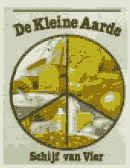 |
|
Source:
http://ificinfo.health.org/brochure/pyramid.htm;
http://www.pz.nl/dekleineaarde/
|
6.3. Indicator development
This chapter has a strong focus on agricultural
inputs and thus on the negative environmental impacts of
agriculture. In future editions, agri-environment indicators
(currently under development) — including indicators on farmers’
activities in landscape management — will also show the positive
impact of agriculture on landscapes and biodiversity. Similar
examples of farmers’ activities, together with indicators on price
premiums, could contribute to a better coverage of response
indicators. More attention might be given to the spatial diversity
in agriculture together with better indicators on intensification
and extensification processes.
At the same time, existing indicators will be
improved to express their environmental significance more clearly,
e.g. irrigated area might include quantity of water and its source,
fertiliser use might include nutrient balances, and pesticide use
might include toxicity data.
| Table 6.1. |
| Units: kg/ha |
| |
1980 |
1985 |
1990 |
1991 |
1992 |
1993 |
1994 |
1995 |
1996 |
| Austria |
70.5 |
72.8 |
60.4 |
58.7 |
54.5 |
53.6 |
52.2 |
52.9 |
48.6 |
| Belgium + Luxembourg |
191.6 |
188.6 |
177.9 |
167.4 |
155.1 |
148.3 |
146.8 |
145.8 |
145.8 |
| Denmark |
167.0 |
172.1 |
173.4 |
160.9 |
144.0 |
138.8 |
136.4 |
124.7 |
125.6 |
| Finland |
|
139.9 |
126.6 |
95.5 |
101.3 |
111.1 |
110.9 |
119.2 |
117.8 |
| France |
123.5 |
123.2 |
125.5 |
125.6 |
105.0 |
107.4 |
111.1 |
113.9 |
119.2 |
| Germany |
|
|
132.9 |
130.7 |
128.0 |
118.1 |
129.3 |
125.2 |
125.4 |
| Greece |
126.1 |
160.4 |
156.2 |
148.5 |
145.0 |
119.7 |
120.2 |
123.9 |
127.4 |
| Ireland |
73.6 |
78.2 |
112.1 |
111.2 |
111.0 |
121.9 |
125.6 |
|
|
| Italy |
99.9 |
98.2 |
88.1 |
92.6 |
90.7 |
|
|
|
|
| Netherlands |
280.0 |
287.8 |
231.4 |
234.5 |
230.8 |
221.6 |
237.2 |
229.7 |
233.8 |
| Portugal |
|
45.3 |
57.31 |
51.9 |
51.2 |
50.4 |
50.3 |
52.1 |
56.9 |
| Spain |
50.6 |
52.4 |
59.31 |
56.6 |
47.0 |
54.5 |
57.8 |
55.2 |
57.8 |
| Sweden |
|
132.2 |
78.77 |
65.0 |
77.0 |
83.3 |
78.7 |
85.6 |
79.3 |
| UK |
89.0 |
110.5 |
106.65 |
97.7 |
89.1 |
96.0 |
102.2 |
100.6 |
101.2 |
| Iceland |
10.18 |
8.7 |
7.70 |
8.0 |
8.5 |
7.8 |
7.2 |
|
|
| Norway |
184.4 |
168.4 |
149.2 |
143.4 |
140.3 |
137.0 |
137.6 |
|
|
| EEA |
108.2 |
111.5 |
104.0 |
100.9 |
92.6 |
93.8 |
97.2 |
96.9 |
96.8 |
| EU |
109.3 |
112.7 |
105.3 |
102.1 |
93.7 |
94.9 |
98.5 |
98.1 |
98.0 |
| Source: FAO; Eurostat/NewCronos |
Notes: Total nitrogen and
phosphorus fertilisers. Liechtenstein not included. Totals for EU
and EEA include estimates for missing years and countries.
6.4. References and further reading
EEA (1999). Groundwater quality and
quantity in Europe. Environmental assessment report No 3.
European Environment Agency, Copenhagen
Birdlife International (1996). Nature
conservation benefits of plans under Agri-environment Regulation
2078/92. Birdlife International, RSPB, The Lodge, Sandy, Beds,
SG19 2DL, UK.
MAFF (1998). Code of Good Agricultural
Practice for the Protection of Water. MAFF Publications,
Admail 6000, London, UK.
Potter, C. (1970). ‘Europe’s changing farmed
landscapes’ in Farming and birds in Europe: the Common
Agricultural Policy and its implications for bird
conservation. Eds: D. J. Pain and M.W. Pienkowski. Academic
Press, London.
Pretty, J. (1998). The Living Land.
Earthscan Publications Ltd, London.
Isart J. and Llerena J.J. (eds) (1996).
Biodiversity and land use: the role of organic farming.
Proceedings of 1st ENOF workshop, Bonn, 1995. European Network for
Organic Farming, Barcelona, Spain.







Document Actions
Share with others